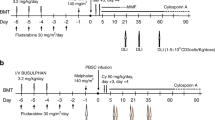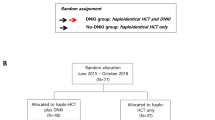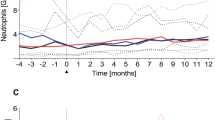Abstract
A majority of patients with intermediate or high-grade non-Hodgkin’s lymphoma (NHL) who are treated with high-dose chemotherapy (HDT) and hematopoietic stem cell transplantation subsequently relapse. Until recently, transplantation was associated with high morbidity and mortality and the focus was on improving the safety of this procedure. However, the use of growth factors and other supportive measures has successfully reduced treatment mortality to less than 5%. Therefore, new strategies need to be developed to eliminate the growth of any occult tumor cells reinfused with the stem cell products and the tumor cells remaining in the patient. One approach is to improve the immune function of the patients by a more rapid immune reconstitution and augmentation of effector cell function. We report studies comparing immune recovery following HDT and autologous peripheral stem cell transplantation (PSCT) as compared to autologous bone marrow transplantation (ABMT). These studies examined patients with intermediate and high-grade non-Hodgkin’s lymphoma (NHL) who were treated with HDT and PSCT (n = 56) or ABMT (n = 60). The PSCT patients had a significantly faster recovery of circulating monocytes (CD14+ cells), natural killer ((NK) CD56+) cells, T helper (CD4+) cells, TCRγ/δ cells, and naive T lymphocytes (CD45RA+). Following ABMT there was a significantly more rapid increase in the frequency of T suppressor/effector (CD8+) cells, B (CD19+) cells, CD34+ cells, polymorphonuclear leukocytes (PMN) and memory T lymphocytes (CD45RO+). The CD4:CD8 and CD45RA:CD45RO ratios were consistently higher in the PSCT group as compared to ABMT suggesting an improved ratio of T helper to T effector/suppressor cells and naive T cells. The differences in cellular phenotype translated into improved T cell function (PHA mitogenesis) and T cell help (pokeweed mitogenesis). In addition, there was an accelerated reconstitution of NK cell activity following PSCT as compared to ABMT. The more rapid reconstitution of NK and T cells in patients rescued with PSCT as compared to ABMT may contribute to an improved clinical outcome. Further, patients receiving a PSCT may be more responsive to adjuvant immunotherapy following transplantation.
This is a preview of subscription content, access via your institution
Access options
Subscribe to this journal
Receive 12 print issues and online access
$259.00 per year
only $21.58 per issue
Buy this article
- Purchase on Springer Link
- Instant access to full article PDF
Prices may be subject to local taxes which are calculated during checkout
Similar content being viewed by others
Author information
Authors and Affiliations
Rights and permissions
About this article
Cite this article
Talmadge, J., Reed, E., Ino, K. et al. Rapid immunologic reconstitution following transplantation with mobilized peripheral blood stem cells as compared to bone marrow. Bone Marrow Transplant 19, 161–172 (1997). https://doi.org/10.1038/sj.bmt.1700626
Received:
Accepted:
Issue Date:
DOI: https://doi.org/10.1038/sj.bmt.1700626
Keywords
This article is cited by
-
Control of hepatitis B virus infection in hematopoietic stem cell recipients after receiving grafts from vaccinated donors
Bone Marrow Transplantation (2016)
-
Lenalidomide and cyclophosphamide immunoregulation in patients with metastatic, castration-resistant prostate cancer
Clinical & Experimental Metastasis (2015)
-
Predictors of mortality in patients undergoing autologous hematopoietic cell transplantation admitted to the intensive care unit
Bone Marrow Transplantation (2009)
-
T-lymphocyte reconstitution following rigorously T-cell-depleted versus unmodified autologous stem cell transplants
Bone Marrow Transplantation (2006)
-
Transfer of the hematopoietic stem cell transplant patient to the intensive care unit: does it really matter?
Bone Marrow Transplantation (2006)



